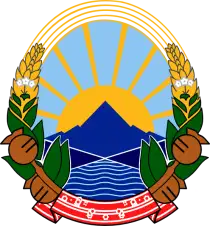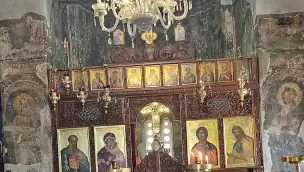North Macedonia is a small but highly diverse country in the Balkans, offering a unique blend of stunning landscapes, rich cultural heritage, and warm hospitality. It is an ideal destination for travelers seeking authentic experiences off the beaten path.
Macedonian cuisine is a mix of Balkan and Mediterranean influences, featuring dishes such as tavče gravče (baked beans in a clay pot), ajvar (pepper paste), and shopska salad.
Odkryj najlepsze loty do blisko sto miast na różnych kontynentach. Sprawdź aktualne ceny i promocje.
Sprawdź loty do blisko sto miast na różnych kontynentachScratched Eyes on Saints` Icons in Macedonian Churches
The phenomenon of scratched faces or eyes on icons in old churches in territories conquered by the Ottoman Empire can be explained through both religious and historical contexts:
Muslim Iconoclasm – In Islamic tradition, the depiction of human and divine figures is prohibited, which sometimes led to the destruction of icons in conquered churches. While the Ottoman authorities generally tolerated Christianity, local fanatics or officials might have defaced saints’ images, particularly their faces and eyes, as a way to erase the “soul” of the depicted figure.
Ordinary Vandalism – During wars, uprisings, or acts of violence, places of worship were often damaged. Icons could be harmed by soldiers, looters, or enemies of the community as a form of humiliation.
Many churches today consider such damage as part of their historical legacy—a testament to difficult times they have survived. In heritage conservation, the principle of minimal intervention often applies, so unless reconstruction is necessary, the original state is preserved, especially when the original appearance is uncertain.
Dispute over the Name of Macedonia
The dispute concerned the official name of the country that declared independence in 1991 after the breakup of Yugoslavia as the Republic of Macedonia. Greece opposed the use of the name “Macedonia” because of several reasons:
- Historical claims – Greeks argued that the name “Macedonia” belonged exclusively to the Greek region of Macedonia and was an integral part of the heritage of ancient Greece (Alexander the Great, Philip II).
- Concerns over territorial revisionism – Greece feared that the Macedonian state might one day claim parts of the Greek province with the same name (although Skopje never had any real plans for annexation).
- Cultural identity – Greece did not recognize that the Slavic population of today’s North Macedonia had any right to the heritage of the ancient Macedonians, as their ancestors arrived in the region only in the 6th century AD.
The issue is not entirely settled, as tensions occasionally arise, especially regarding the use of Macedonian symbols by Skopje.
Who were the Macedonians?
Whether the ancient Macedonians were Greeks is one of the more controversial topics in historiography. Modern research suggests that Macedonian culture had much in common with Greek culture but also displayed certain distinct features. Key issues concern ethnic identity, language, and how Macedonia was perceived by other Greeks.
The Macedonians were on the periphery of the Greek world. The Kingdom of Macedonia, located north of Thessaly, gradually became culturally closer to Greece. Some Greek sources suggest that the Macedonians were regarded as semi-barbarian. Thucydides and Herodotus refer to Macedonia as a peripheral area of the Greek world.
The language spoken by the Macedonians remains a matter of debate. Written sources are scarce, and most preserved texts from Macedonia are in classical Greek, reflecting the language used by the elite.
However, there were dialectal differences – inscriptions and Macedonian names show features absent in other Greek dialects. Some theories suggest that the Macedonian language was either:
- A Greek dialect – closely related to Aeolic or Doric Greek.
- A separate Indo-European language with Greek influences.
- A mixed language containing Thracian and Illyrian elements.




